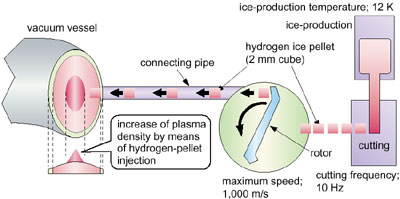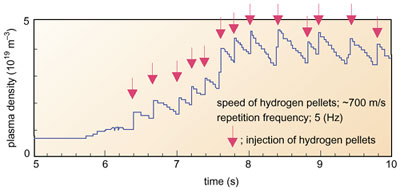Hydrogen ice pellet injection is one of the most promising fuel-injection systems into fusion reactor plasmas. The JAERI attained the launch of a hydrogen ice pellet with a speed of 2,300 m/s accelerated by a hydrogen gas pressure of 200 atm. The high-pressure-accelerating method is, however, not applicable to high-frequency repetitive injection. The centrifugal pellet injection, which has been envisaged to be applicable to it, has been developed elsewhere in the world. JAERI has also developed an applicable method in cooperation with Max-Planck-Institut fur Plasmaphysik.
Figure 3-10 shows a schematic view of the centrifugal pellet injection system. The process of pellet launch is, at first, to make a rod-shaped ice by cooling down deuterium gas to 12 K, and next to cut it at regular intervals and then to drop the cut pellet on the center of a fast-rotating rotor. The pellet is accelerated through a groove of the rotor, leaves its periphery and is finally injected into plasmas.
A difficulty in the development is to overcome the unfavorable effects of sublimated gas released from the pellet. The sublimated gas increases the temperature of the ice-production part and disturbs the flight trajectory of a pellet injected from behind. Unexpected behavior was observed namely that pellets could not reach the plasma and two injected pellets stuck to each other.
In order to overcome the difficulty, we prevent the ice-production part from experiencing a temperature rise by vacuum-sealing between the ice-production and acceleration parts and also we prevent the accumulation of sublimated gas by providing gas-evacuation holes in the acceleration part. In addition, in order to get a smooth motion of the pellet, some design features were implemented, for example, a pent roof at the groove of the rotor and a funnel for the ejection pipe connected to the rotor.
As a result, we obtained the successful launch of 2 mm-cubic deuterium pellets into JT-60 plasmas with a speed of 700 m/s, a repetition rate of 5 pellets/s and a longest launch-duration of 10 seconds. Figure 3-11 shows the time-dependent behavior of the JT-60 plasma density. The density increases stepwise simultaneously with pellet injection.
Higher performance is needed in the field of the uniformity of pellet size and repetition time for realization of a commercial fusion reactor. However, the above-mentioned result gives a bright prospect for it. |


